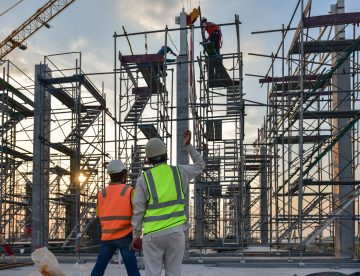
Earlier this month, we reported on how the construction industry in the UK will need over a quarter of a million extra workers by 2026, including 26,000 in Greater London and 24,600 across the East of England.
This is going to be a real challenge, not least because the numbers of young people looking to enter the sector are far below the numbers of older workers who are leaving their trade. One YouGov Omnibus survey found that only 3% of young people aged 18-24 had searched for a job in construction.
As schools and colleges across the country come to a close, it’s likely there are a great many young people who haven’t fully decided what to do next. To help, we thought we’d share what we know about some of the key construction trades and so the focus of today’s blog is roofing.

While holidaymakers in the UK may be enjoying the recent heatwave, construction workers and others who mostly work outside may be finding the weather slightly more uncomfortable.
With temperatures heading above into the mid-30°Cs, some forecasters are warning that by Sunday, we could exceed the UKs record for the hottest day (which was 38.7°C in July 2019). Added to the fact that the heatwave is expected to continue for at least another eight days, the Met Office have issued an Amber weather warning for extreme heat, meaning that it could result in travel disruption, serious illness and even danger to life.
To help everyone stay safe and well, we’re focusing today’s blog on the health impacts of hot weather and what you can do to avoid them.

Over a quarter of a million extra construction workers may be needed by 2026, according to the latest Construction Skills Network report. That’s over 53,000 new recruits per year for the next five years!
Published annually by the Construction Industry Training Board (CITB), the report looks into the UK’s construction economy and makes key predictions about what will happen in terms of labour/ skills needs over the coming years.
Check out this week’s blog for more details of what this year’s report had to say plus what it means for the sector and our region.

Once upon a time (before we headed into today’s digital world), the main distraction most of us had during a working day was a conversation about the best of last night’s television over tea break!
But now, with notifications informing us of the arrival of the latest email, text, WhatsApp or social media post/ story, our working days can sometimes feel like one long interruption, resulting in little progress on the ‘to do’ list.
There are, however, methods which can be used to get around this problem so, today, we’re going to look at an approach called ‘deep work’. Read on to find out how you can kill those distractions and get more done.

After a couple of challenging years, many had big hopes that 2022 was going to offer the construction sector a slightly easier path. However, as we now know, the challenges have continued to rain upon our industry – not least of which have been issues around the availability and cost of materials plus labour supply.
More positively, the sector seems to have retained its ability to adapt and love of innovation and these are qualities that can be clearly seen in some of the current architectural design trends. From incorporating more natural lighting to introducing more efficient processes into projects, the design work that’s happening right now is surely leaving its mark on the homes of the future. Keep reading this week’s blog for some of the top trends we’ve come across…

A few weeks ago, we published a blog with some tips about managing and improving something that plays a huge part in every construction project – quality. We looked at how important it is to set out goals, carry out tons of forward planning, create work lists for each and every phase of a project, make inspection plans and to monitor, review and learn from every experience.
However, even with the very best intentions to keep on top of all of this, once a project is underway those intentions can be slipped up and brought to the ground by unexpected obstacles or even by a single mistake that compromises quality and/or safety. As a follow up to our previous blog, today we’re delving into four key factors than can cause such a fall – Systems and audits, Changes, Materials and suppliers, and Human error.

As construction companies continue to face challenges around the supply and cost of materials, the Construction Leadership Council have got together with industry experts to launch a five-point plan to ease the impact.
While many of the factors causing the materials crisis are acknowledged to be outside the control of businesses, experts or even the government, the CLC’s plan seeks to co-ordinate an industry-wide effort to minimise risk and reduce the impact of inflation wherever that’s possible.
Keep reading for more on what’s causing this problem and what’s included in the plan.

Across the world, it’s estimated that around 1.5 billion vehicle tyres are discarded every year. Most of us have probably never really thought about this or what might be happening to such a mountain of tyres once they’ve been cast off. While some may get strung up to a tree to make a swing, such repurposing is really an exception to the rule. In fact, less than one percent of old vehicle tyres are ever reused, meaning huge quantities wind up in stockpiles and landfill.
Now, researchers from the University of South Australia (UniSA) have come up with something that could not only help to resolve the landfill problem but also provide an economically viable and sustainable alternative to concrete for the construction industry. Read this week’s blog for more about this exciting development.

The term ‘quality’ can mean different things to different people – the secret to achieving high standards; a measure that we use to evaluate ourselves and others; or a complex set of criteria, controls and procedures that our professional work must adhere to.
For a simpler definition, quality is really all about what separates the good from the bad. For construction projects and businesses this couldn’t be more important, so today we’re going to dive into why that is exactly as well as offer a few tips for how to manage and improve quality.

